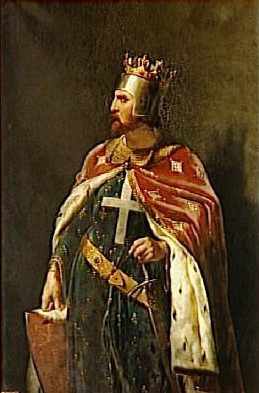This Day in History: September 3rd
Today in History: September 3rd
 This Day In History, 1189 : Richard the Lionheart Crowned King of England
This Day In History, 1189 : Richard the Lionheart Crowned King of England
Richard I, an iconic medieval symbol of chivalry, didn’t ascend the English throne until the age of 31, but had been boldly leading armies since his teens and was an indispensable figure during the Crusades. He’s one of the best known rulers of that era, despite the fact he spent very little time in the country that provided him his crown.
Richard was only the third son of Henry II and the formidable Eleanor of Aquitaine, and came to the throne by means worthy of any Borgia. The eldest male of the family had died while still a small child, igniting a quest for power between The Dad, Henry II; Big Brother, Henry; Richard; and Kid Brother, Geoffrey that dragged on for years, until Geoffrey finally flipped and killed his brother Henry.
This act of fratricide left Richard first in line to the throne, and he attempted to speed up the process by trying to take it by force with the help of the French King Phillip II. In early July 1189, the deciding battle for the crown was waged in southern France, where Henry II was defeated and died on July 6. Richard was officially crowned King of England at Westminster Abbey on September 3.
Richard the Lionheart ruled for less than ten years, spending much that time in his French dominions or away on one crusade or another, leaving England in the hands of trusted associates including his shrewd mother. Despite his disinterest in actively ruling his country, his subjects revered him, and nearly a thousand years later his name and deeds are still commonly spoken of. How many rulers of that era can boast that?
This Day In History, 1783: The American Revolutionary War Ends With the Treaty of Paris
The long years of bitterness, sacrifice and deprivation of the American Revolution finally came to an end when representatives of the brand-spanking-new United States, along with Great Britain, France and Spain gathered to sign the Treaty of Paris.
This was the first formal British recognition of the independence of its 13 former colonies, and America’s debut as a free and independent nation. The new nation’s boundaries were also established – from the tip of Florida north to the Great Lakes, and from the Mississippi River stretching all the way east to the Atlantic Ocean. (Later, someone would come up with “manifest destiny” and all hell would break loose, but at least for now everyone could savor the moment.)
In 1782, the Continental Congress had chosen a five-person committee including Benjamin Franklin, John Adams, John Jay, Thomas Jefferson and Henry Laurens to initiate peace negotiations with the British. Both Laurens and Jefferson were absent from the proceedings – Jefferson had travel issues, and poor Laurens had been nabbed by the Brits and tossed in the Tower of London. When talks began in September 1782, only Ben Franklin, John Jay and John Adams were present to represent the U.S., but still the job was done. The treaty was signed that day, and ratified by the Continental Congress on January 14, 1784.
Expand for References| Share the Knowledge! |
|




